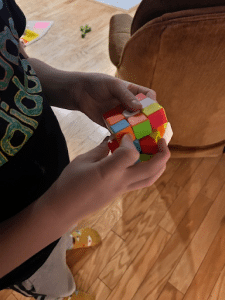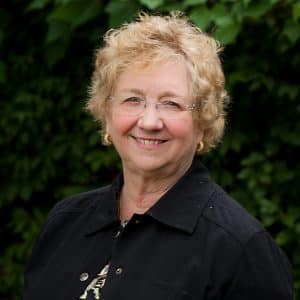Mindsets and Resources for Unleashing Learner Agency
CompetencyWorks Blog
We’ve all witnessed moments when a child tackles a problem in a way that surprises us, experiencing the utter joy of success. Consider the story of seven-year-old Michael, attempting to solve the Rubik’s Cube challenge with determination and agency, eventually finding an innovative solution.
 Imagine for a moment the interaction between Michael and the elusive alignment of the Rubric Cube’s colors on each of six sides. For about 20 minutes, Michael remained focused, concentrating as little hands twisted and turned the cube in all directions, trying to achieve perfection in the form of solid panels of red, green, yellow, blue, orange, and white. He was caught up in the moment, consumed by the desire to figure out how to solve the puzzle.
Imagine for a moment the interaction between Michael and the elusive alignment of the Rubric Cube’s colors on each of six sides. For about 20 minutes, Michael remained focused, concentrating as little hands twisted and turned the cube in all directions, trying to achieve perfection in the form of solid panels of red, green, yellow, blue, orange, and white. He was caught up in the moment, consumed by the desire to figure out how to solve the puzzle.
Michael’s focused efforts to align the Rubik’s Cube’s colors led him to investigate an unexpected solution. Despite initially relying on trial and error, he turned to an online resource using his iPad and discovered an online Rubik’s Cube solver. Driven by his personal desire to solve the problem, and using the instructions on his iPad, he was totally rewarded by conquering the Rubik’s Cube and unknowingly showcasing his capacity for personal agency.
Now imagine what would be possible if we could harness that type of learning power with our students. As educators, the challenge lies in unlocking the potential for concentration, determination, tenacity, and perseverance in subjects like reading, writing, social studies, science, and math.
Michael’s journey highlights the importance of investigating new models of teaching and learning that allow learners to be more self-directed and actively pursue solutions to the problems they are trying to solve.
Decoding the Relationship Between CBE and Rubik’s Cubes
Those familiar with the principles of competency-based education (CBE) will recognize the importance of this. The CBE approach opens the door for an opportunity to shift from the limitations of traditional classroom practice into a more energized environment; a place in which all our students, including Michael, can thrive.
Those engaged in a CBE model are well equipped to empower their students in this way. As the Aurora Institute states in its revised 2019 definition of CBE: “[in a CBE classroom] students are empowered daily to make important decisions about their learning experiences, how they will create and apply knowledge, and how they will demonstrate their learning.”
In our example, Michael demonstrated that he has the potential to tackle a challenge, show determination, and conquer the learning expectations of the day. The CBE classroom model embraces Michael’s innate capacity as a learner within an environment that sparks curiosity and excitement.
CBE classrooms provide avenues of varied pacing, multiple pathways of learning, timely feedback, and differentiated support. The expectations in a day of student learning are clearly more complex than our example of one child and a puzzle. But the foundational need for engagement and self-direction is most relevant. 
The recently released publication, Agency by Design: An Educator’s Playbook, available free to download on the Aurora Institute Website, supports this. The playbook provides educators with insights, conversation starters, and practical guidance for fostering learner agency in the classroom. This newly released 200-page resource provides a platform for transitioning our classrooms into a CBE model.
The playbook encourages educators to seek and cultivate the same curiosity, tenacity, and self-determination witnessed in Michael’s Rubik’s Cube journey. Real-world examples within the playbook demonstrate agentic behaviors in classrooms, providing inspiration and a roadmap for change.
This book isn’t simply a text about learner agency and CBE. It is a call to action, providing the frameworks, tools, strategies, and user-friendly rubrics to guide you as you unlock the potential of your students as they embrace their personal ownership of learning. This resource provides a mix of the theoretical with the practical steps taken from lived experiences from educators who desire more for their students in their learning experiences. The playbook looks at two distinct dimensions within the classroom – both of which are required for authentic change to occur.

Exploring the Essential Dimensions of Agency by Design
First are the “conditions” created by the Teacher. This includes things such as how to increase motivation and engagement among your learners, how to provide the kids with the support and supervision that will promote more agentic learning, and how to structure the learning environment so that this can happen. There’s a focus on the design of learning, the nature of curriculum, acts of teaching, and rethinking the measures of success required here.
The second part of the framework identifies the resulting desired “characteristics” that should be observed in students. This includes things such as collaboration, digital literacy, and learner-driven learning. There’s an emphasis on building the capacity of learners to assess their own learning and focus on the competencies that will set them up for success now and into the future.
The labels used to describe the conditions and characteristics in each section of the playbook will be familiar to educators. What is unique is how those labels represent new opportunities for increased agentic behaviors by both students and teachers. The potential outcomes of these shifts in practice include new relationships between learner and teacher, new environments of learning, and more ownership of the process by the students.

Implementing agentic practices within a CBE model doesn’t require a complete or immediate overhaul, and within a CBE model, in particular, they align and enhance the goals of CBE. Small changes that give students more voice and choice can have a profound impact. The playbook provides prompts and practical steps to take to begin making these things happen in your school or classroom context. It contains suggestions and insights from practice to guide educators in taking bold yet manageable steps toward fostering learner agency.
As educators, it’s time to “play” and explore shifts that allow students and teachers to embark on the learning journey together. Starting small, thinking big, and inviting student input are crucial steps. While challenges may arise, colleague conversations and student involvement can provide valuable support.
Just as Michael’s passion for the Rubik’s Cube can be harnessed for learning, educators can connect with students’ passions in various subjects. Taking a leap of faith, creating opportunities for agency to shine through, and designing engaging lessons are not only desirable but entirely achievable. It’s time to empower students and educators alike on the path to meaningful, self-directed learning.
Learn More
- Advice from the Field: Initiating, Sustaining, and Scaling Personalized, Competency-Based Learning
- “Ins” and “Outs” of CBE in 2024
- Implementation with Integrity
 Marsha Jones is an experienced educator with over 50 years of service. During Marsha’s tenure with the Springdale School District, exponential growth brought a tremendous increase in diversity and shifts in overall socio-economic status. It became readily apparent in order to realize the goal of “learning for all”, a fundamental shift in educational practices would be required, based on the concepts of personalizing learning, building on student assets and strengths, and developing student agency. Upon retiring, she is an avid author and continues to teach. She was the Associate Superintendent with the Springdale School District, Springdale, Arkansas. Currently, she is an adjunct professor at the University of Arkansas, teaching in the Arkansas Impact Fellows Program for aspiring administrators, funded by the Walton Family Foundation.
Marsha Jones is an experienced educator with over 50 years of service. During Marsha’s tenure with the Springdale School District, exponential growth brought a tremendous increase in diversity and shifts in overall socio-economic status. It became readily apparent in order to realize the goal of “learning for all”, a fundamental shift in educational practices would be required, based on the concepts of personalizing learning, building on student assets and strengths, and developing student agency. Upon retiring, she is an avid author and continues to teach. She was the Associate Superintendent with the Springdale School District, Springdale, Arkansas. Currently, she is an adjunct professor at the University of Arkansas, teaching in the Arkansas Impact Fellows Program for aspiring administrators, funded by the Walton Family Foundation.
 Derek Wenmoth is regarded as one of education’s foremost future-focused thinkers. He works extensively with schools and systems in New Zealand (NZ) and elsewhere as they seek to prepare students for their future. He also consults with policymakers and government agencies regarding the future directions of NZ educational policy and practice. He is currently running FutureMakers, an educational consultancy focused on making our education system more future-focused by inspiring the next generation of leaders, thinkers, and problem-solvers.
Derek Wenmoth is regarded as one of education’s foremost future-focused thinkers. He works extensively with schools and systems in New Zealand (NZ) and elsewhere as they seek to prepare students for their future. He also consults with policymakers and government agencies regarding the future directions of NZ educational policy and practice. He is currently running FutureMakers, an educational consultancy focused on making our education system more future-focused by inspiring the next generation of leaders, thinkers, and problem-solvers.